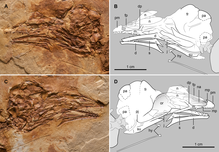Junornis
| Junornis | ||||||||
|---|---|---|---|---|---|---|---|---|

Junornis skeleton: plate and counter plate |
||||||||
| Temporal occurrence | ||||||||
| Lower Cretaceous ( Aptium or Barremium ) | ||||||||
| approx. 126 million years | ||||||||
| Locations | ||||||||
| Systematics | ||||||||
|
||||||||
| Scientific name | ||||||||
| Junornis | ||||||||
| Liu , Chiappe , Serrano , Habib , Zhang , Meng , 2017 | ||||||||
| Art | ||||||||
|
||||||||
Junornis is an extinct genus of the Enantiornithes . The generic name is derived from the Chinese jun "beautiful" and from the Greek ornis "bird".
The only known species is called Junornis houi . The species name honors the paleontologist Hou Lianhai.
It was named and described in 2017 by Liu Di, Lius Maria Chiappe, Francisco Serrano, Michael Habib, Zhang Yuguang and Meng Qinjing.
remains
The fossil (holotype BMNHC PH-919) was discovered in the Yixian Formation , near the city of Daming ( Inner Mongolia ). It is estimated to be around 126 million years old and thus lie in the Lower Cretaceous ( Aptian or Barremium ). The holotype consists of a largely articulated skeleton with a severed skull . Extensive remains of the plumage have been preserved.
The intermaxillary bone has four teeth, the front two of which are pin-shaped. At least seven teeth can be seen on the lower jaw. The basin is very wide. The pygostyle is rather short and ends in a sharp point.
particularities
Junornis were small birds weighing approximately 30.4 grams. On the tail there are two control feathers that are approximately 20 cm long, longer than the actual body size of the bird. The wings were short and wide: the wingspan is estimated at 30 cm and the wing area at 170 cm². Therefore, it is believed that Junornis were very nimble and agile. It is the first specimen from the Jehol group to be classified as enantiornithes.
Individual evidence
- ↑ a b c d e f D. Liu, LM Chiappe, F. Serrano, M. Habib, Y. Zhang, Q. Meng: Flight aerodynamics in enantiornithines: Information from a new Chinese Early Cretaceous bird . In: PLoS ONE . 12, No. 10, October 11, 2017, p. E0184637. doi : 10.1371 / journal.pone.0184637 . Retrieved June 18, 2019.
